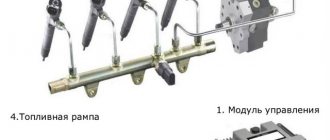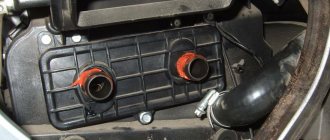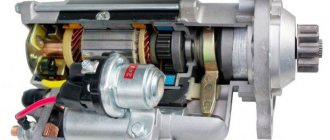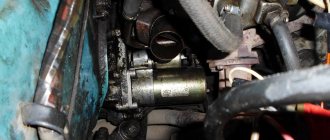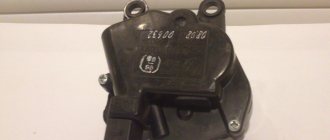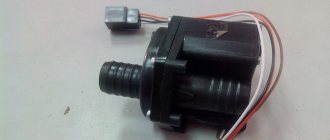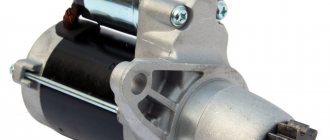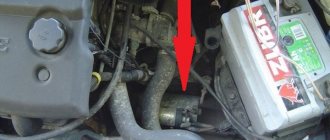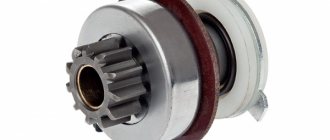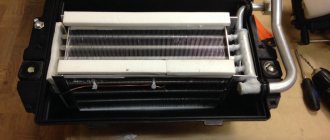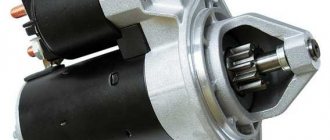Gazelle Next is equipped with diesel, gasoline and gas engines.
Regardless of the type of power plant, during operation, the car owner may be faced with a situation where his car does not start.
If the engine does not start, it is important for the driver not to panic, but to take troubleshooting measures.
GAZelle starter: device, malfunctions, repairs
Sooner or later, any owner of a Gazelle Business or Next with a Cummins diesel engine may encounter a problem - the car will not start.
You need to go on a flight, but the car is parked and it’s not clear what happened, because everything seemed to be fine. What to do in this case? Let's try to understand the main reasons for this phenomenon and what needs to be done to eliminate them.
Let's say right away that we will not consider such obvious reasons as lack of fuel in the tank and a dead battery. We really hope that your driving experience is enough to independently identify and eliminate these causes.
If you require original spare parts for the Cummins ISF 2.8 engine, you can always purchase them in our online store.
Call and get a free consultation with a specialist right now!
8-800-100-24-93
free call from mobile
Let's check the retractor
If voltage comes to the control contact of the retractor relay, the ground is not broken, but the starter refuses to cooperate with you and does not turn, do the following.
- Be sure to remove the car from gear and put the handbrake on;
- Turn the key to the “ignition” position;
- We take a 17mm wrench and use it to bridge the power terminals of the retractor.
If the starter spins vigorously, then our problem is in the solenoid relay itself. The easiest way would be to simply replace it with a new one, but you can try to repair it.
We remove the starter and unscrew 3 screws (2 screws for ZMZ 406) securing the retractor. We unscrew the screws securing the contact group and examine the condition of the contact “penny” and the contact pads of the bolts. Most likely, we will find severe burning on them. We clean the contacts and make their surface absolutely smooth and flat. We carry out a similar operation with a nickel. A badly eaten penny, you can simply turn it over if this has not been done before.
We will also use a tester to check whether the relay windings are shorted to the housing and whether there are any breaks in them. If everything is normal, put everything back together and try to start.
Intake air heating coil
For the fuel mixture to ignite, it must be at a certain temperature. And in order for the mixture to reach the desired temperature, Cummins ISF 2.8 engines have an element called an intake air heating spiral (candle).
This engine element starts working at low temperatures. It is located in the engine intake manifold and starts working after turning the ignition key. In principle, in the summer, when it’s warm outside, you can do without this detail. But on frosty days, starting the engine with the intake air heater not working will be very problematic.
Therefore, in the cold season, the first thing you need to do is check whether the intake air heating coil is working. This is easy to do - when the spiral is running, the intake manifold should be warm.
It is necessary to inspect the contacts of the spiral and the wires going to them. It often happens that the wires simply break. But sometimes it happens that the spiral itself fails. In this case, only replacing it will help.
Why the starter does not turn or turns slowly, common causes and solutions
Everything applies to Gazelle cars and not only... “Why doesn’t the starter turn”, “Something clicks under the hood and there’s silence” or “There’s a click and everything goes out” - such questions can often be seen in discussions on car forums. These are the most common signs of problems with the wiring, solenoid relay, bushings, or the starter motor itself. Let's look at a few of the main and most common causes of starter failure. We will assume that the engine itself, the crown (its teeth) are in good condition, and the battery, especially in the cold season, is charged and does not lose charge due to a consumer unknown to the owner.
And so, when you turn the key, nothing happens or clicks are heard in the engine compartment (one or a series of them). In most cases, the problem lies in poor contacts. Unfortunately, there are not one or two contacts that are important for the operation of the starter. If your car is not new, the problem may be hidden in the power wires, ground - their terminals. It is important that there is reliable contact on ALL wire terminals. These wires can be perfectly pinged by the tester, but when the starting current runs through them, they simply will not pass the power that is needed to start the starter.
The stranded power wire is simply crimped with a terminal and is not protected from external influences. Over time, the contact deteriorates at the crimping site - dirt and water from the road get in and corrosion occurs. Often, with such wires, the starter does not turn the first time in damp weather, after rain. To quickly restore contact, sometimes you have to remove the terminal and tap the wire at the crimp point on a hard surface. The best option for solving problems with wires is, of course, replacing them with new ones; or disassembling terminals, stripping, tinning, re-crimping and soldering. Moreover, the places where the terminals are pressed through washers with nuts (the weight of the cabin, the engine, the power plus on the retractor) are most often deformed and also have traces of corrosion - this is also an obstacle to good contact. It is advisable to straighten them, clean them and re-tin them. For me personally, the option of tinning and soldering gave the desired result. Another contact that can prevent the starter from starting is the contacts on the battery itself. They also need to be kept clean and dry. Therefore, many, having secured the wire to the battery terminal, cover this place with thick lubricant on top.
Battery problems
If the Gazelle does not start, then you should start searching for the impossibility of starting the engine with the battery. If it is insufficiently charged, the starter does not have enough energy to turn the crankshaft. In this case, a significant drop in the on-board network voltage occurs. The traction relay starts to click, but the engine cannot start.
ATTENTION! A completely simple way to reduce fuel consumption has been found! Don't believe me? An auto mechanic with 15 years of experience also didn’t believe it until he tried it. And now he saves 35,000 rubles a year on gasoline! Read more"
The situation with starting the engine with a discharged or old battery is aggravated in cold weather. There are two reasons for this:
- engine oil thickens in the cold and it becomes more difficult for the starter to crank the crankshaft, which causes increased starting current and greater battery energy consumption;
- When it's cold, the chemical reactions of the battery slow down and the battery becomes able to deliver less charge.
In winter, both of the above reasons overlap each other. Starting becomes especially difficult when cold. Under unfavorable conditions, the car may completely refuse to start.
With a discharged battery, many car owners start their Gazelle only with a pusher, but there are other ways, the main ones being:
- start using ROM;
- “lighting up” from another vehicle;
- charging the original battery with a nominal or increased current and then starting the power unit.
A situation with a discharged battery does not require special attention from the car owner if it occurs only once. It is enough to recharge the battery and you can continue to operate the machine as before. If the battery dies often, then it is necessary to diagnose it. Based on its results, a decision is made on the method and feasibility of restoration work. In some cases, it is more rational to purchase a new battery.
If the battery shows full serviceability, but dies in a short period of time, then the on-board network must be checked. It may contain short circuits and high leakage currents. If they are identified, you should not delay troubleshooting. Prompt resolution of problems will eliminate the risk of a car fire.
The presence of through cracks and other similar defects leads to the loss of part of the electrolyte. The battery's ability to deliver starting current and energy is significantly reduced. To diagnose the problem, just carefully inspect the case. If any damage is detected, the car owner is faced with a choice between carrying out repairs or purchasing a new power source.
What to do if the Gazelle stalls while driving?
If the Gazelle stalls while driving, then the first thing you need to do is look at the fuel, or rather its supply.
It is necessary to inspect the engine compartment for fuel leaks. It happens that due to vibrations, the fixing bracket unscrews and the tube from the injection pump to the ramp bursts.
Even a small crack in the tube will be enough for the pressure in the system to drop and the engine to stop working. This phenomenon is usually accompanied by a yellow check.
If everything is in order with the tube from the injection pump to the ramp, we recommend continuing to inspect the fuel system and pay attention to the fuel filter housing. Sometimes it happens that its top cover fails and air begins to leak through it.
Security system and its influence on car starting
If, when you try to start the engine, the starter does not turn and the Gazelle Next does not start, then the security system may be the culprit. Working in normal mode, it protects the car from theft. Incorrect installation or failure of one of the units leads to the fact that the alarm interferes with the successful start of the internal combustion engine.
To identify problems, it is recommended to completely dismantle the security system from the car. After this, carry out a test run. If it is successful, then the culprit of the trouble is among the car alarm modules.
Why doesn't the car start?
If your car does not start, then most likely there is no gas in the tank. However, if you turn the ignition key and nothing happens, then there is a 99% chance that the battery is dead. There is a 1% chance of an open circuit.
To begin with, we recommend looking under the hood and making sure that both wires are connected to the battery terminals and there are no visible wire breaks. If everything is in order with the wires, then check the voltage at the terminals with a regular tester; it should be at least 10 volts.
Although at least electrical appliances can operate at a lower voltage, the starter will no longer be able to turn.
If the battery is already old, then you can buy batteries for trucks in the nearest store or online, but first you need to decide on the following characteristics:
For those who don’t know, we hasten to inform you that you should always remember about the battery. After all, it is he who is responsible for starting the engine, and also ensures the operation of all electrical circuits of the car when the engine is stopped. For example, side lights when parking, or hazard warning lights. Starter batteries are divided into three main types:
The stator or rotor windings are shorted
If the starter not only does not turn the engine (you can’t hear the sound of turning), but also emits a smell of burning insulation, it most likely burned out due to a short circuit. The main “enemy” of the electric starter is overheating, which destroys the varnish coating of the windings. Old-style gearless devices (with an excitation winding) especially suffer from overheating. Exposed wires always threaten a short circuit. An interturn short circuit of the armature (or a breakdown to ground) is indicated by a deterioration in the efficiency of the electric motor: the flywheel turns slowly, with great “reluctance”. You can check the stator and armature only after removal - visually, for a wire break, with a “continuity test”, using load clamps.
Air leak
Very often, the cause of poor engine starting can be a banal air leak. From our experience, it most often occurs through the intake pipe in the tank or through a failed separator cover. To check for air leaks in the fuel system, it is necessary to replace the fuel pipe from the filter to the injection pump with a transparent hose.
Bubbles in the fuel will immediately indicate the presence of air leaks. As we have already said, it is necessary to check the separator cap and the intake pipe in the tank, as well as all connections of the fuel pipes.
Disassembly
How to disassemble the starter yourself? The GAZelle continues to stand still, and we take the element out. First of all, remove the back cover. It is attached to two studs. You will need a key “10”. If the lid is difficult to remove, you can use a hammer. With light blows we take it out. We take out the brushes, winding, armature and plate. We inspect the condition of the elements. Since we have a gear starter, we add a little lubricant to the gear element.
We also treat the rolling bearing with oil. It is unacceptable for there to be oxides and rust inside. To eliminate this, use carburetor cleaner. The composition thoroughly washes away all dirt from the cover and insides of the starter. But be careful - the product is highly poisonous. You need to wear protective gloves when working. After cleaning the element from dirt, we check the winding for mechanical damage. In case of any deformation, the part must be replaced. It doesn’t matter whether it’s an armature, a winding, a plate or another element. It is very important to inspect the bendix teeth. If they are worn out, the element is replaced with a new one.
How to check injectors on a Gazelle with a Cummins ISF 2.8 engine yourself
In order to independently check whether the injectors are draining into the return line, you need to use ordinary medical syringes. For more information about this, watch Denis Gorban’s video
If the injectors are delivering too much fuel to the cylinders, the fuel mixture will not be correct and the fuel will not burn completely, causing you to see thick black smoke coming from the exhaust.
Thick black smoke may also be due to a clogged air filter, but if the cause lies in the injectors, we recommend that you stop using the vehicle immediately. Otherwise, due to too high a temperature in the combustion chamber, the engine may overheat or the piston may melt, which in turn will lead to expensive overhauls.
Fuel cells
Troubleshooting the stove fan
It is worth understanding that almost all elements affect the starting of the motor. For example, since the Gazelle was produced both with carburetor and injection, the injection elements will be different. This means that the reasons for possible breakdowns will not be the same.
The Gazelle-406 engine is an injection version of the vehicle. It has injectors installed, which can be the source of the problem. If cleaning has not been carried out, then most likely the injectors are dirty. To fix this, you need to remove the parts from the machine and send them for cleaning. If, during the process of restoring the functionality of the injectors, it turns out that the product cannot be repaired, then it must be replaced.
A fuel pump malfunction may be due to a breakdown inside the module. To check whether the pump is pumping, you need to get behind the wheel of the car and turn the ignition key to the second position. In this case, a characteristic noise should begin from behind, which will mean that the pump is in working condition.
Particular attention should be paid to the condition of the fuel filter. According to the service manuals and recommendations of the manufacturer, the fuel filter element must be changed every 40,000 km.
If this is not done, the filter becomes clogged and does not allow fuel to pass through properly, which results in a lean mixture in the cylinders, or gasoline does not get in for ignition at all.
Read more: Exiting the acceleration lane, who is inferior?
Faulty injection pump
The reason that the car does not start may be a breakdown of the high pressure fuel pump. The injection pump fails due to the following reasons:
The first two reasons for fuel pump failure are obvious. Why does the fuel injection pump break down due to air leaks? The fact is that modern common rail system pumps do not have a separate lubrication system and are lubricated with diesel fuel.
And when there is air in the fuel, the injection pump begins to run “dry”, which is why the friction between the pump elements increases significantly and over time it begins to drive metal shavings.
These metal shavings can cause fuel injectors to fail over time. If you need to turn the starter for a long time to start the engine and if the engine runs unevenly and with vibrations, then most likely this indicates an air leak.
In order not to destroy the fuel system and avoid expensive repairs, we recommend eliminating this air leak as soon as possible.
Also, the cause of poor starting of the internal combustion engine can be a jammed check valve on the fuel injection pump. This happens rarely, but it does happen. Therefore, we recommend that you check it as well.
Common Cummins maintenance tasks:
- Regular oil changes
- Fluid replacement
- Replacing the air filter
- Replacing the fuel filter
As for filters, it is probably a good idea to replace them according to the manufacturer's recommendations. You can find such information on the packaging or on the manufacturer's website.
What to do and what not to do...
It's a well-known fact that an ounce of prevention is worth more than a cure, so perform preventive maintenance to avoid wear and tear. Also pay special attention to the fuel injector, replacing the injector will save you money, don't wait until it eventually cracks. Another helpful tip is to add a bottle of diesel every time you fill the tank. This will prevent the diesel fuel from becoming saturated with impurities floating around your tank, which will prove beneficial to your parts.
Do not drain engine fluids until they are at a cool temperature. Diesels tend to run much hotter than gas engines, and if they are hot, it can cause serious injury and, more importantly, engine damage.
Key diesel engine components to watch out for...here's a short list of symptoms to look out for:
Gasket leak:
The extreme pressure your gaskets endure can cause them to wear out. If the engine produces a high-pitched sound, then there is a chance that it could be the diesel fuel pump. Different pumps will make different sounds, but this gives you a reason to start checking.
Thick smoke:
If you see a trail of thick smoke following you from your rearview mirror, the color of the smoke may reveal the source of the problem.
- Black: Diesel injector, pump or air filter is faulty.
- Blue: Engine oil burning.
- White: Possible water ingress into the engine or low compression.
Causes of malfunction
If the starter turns poorly when the battery is charged, then the breakdown, in most cases, is in the engine starting device.
The reason for the low engine speed, in this case, may be:
Before you begin to identify the above reasons, you should make sure that the battery produces sufficient current to start the engine. To do this, you can use a load fork. If the battery is serviceable, it is necessary to measure the density of the electrolyte.
Wiring faults
The starter of an internal combustion engine is the most energy-intensive piece of electrical equipment in a car, so poor-quality fastening of wires and terminals can reduce the efficiency of this device.
The current strength that occurs when the starter is turned on is so high that an electric arc can form in wires that are not well attached. Part of the energy will be spent on maintaining this effect, as a result of which the starter will rotate very slowly.
In addition to insufficient current in the circuit, an electric arc can lead to a fire, so if the battery does not turn the starter well, you should first inspect the battery connection terminals, and also check the quality of the connection of the positive wire, which is connected from the “+” battery to the solenoid relay.
You should also check the cable that connects the engine housing to the car body; there may also not be good enough contact in this place.
In addition to electrical leakage and loose nuts and bolts, the starter may lack electrical power due to oxidation of the battery terminals. In this case, a layer is formed of a substance that poorly conducts electric current, which is the reason for the deterioration of the starter’s performance.
This problem can be easily solved if you use a soda solution to remove the resulting oxidation layer:
Defective solenoid relay
A very common breakdown that can cause poor performance of the car’s starting mechanism.
If a short circuit occurs in the electromagnet winding, then this part will need to be completely replaced, but in most cases the reason for the unsatisfactory operation of the solenoid relay is a malfunction resulting from burning of the relay contacts.
Clogged intake tube in the tank, air or fuel filter
Another reason that your Gazelle with a Cummins engine does not start may be a clogged fuel or air filter.
When the fuel filter is clogged, we do not receive the required amount of fuel, and when the air filter is clogged, there is correspondingly little air. If the car jerks or there are dips in dynamics, check all filters. They need to be changed at least once every 15,000 km.
GAZelle NEXT (2018). The starter turns, but the engine does not start
There can be quite a few reasons for this behavior of a car. The main ones are listed below
: You forgot to turn off the anti-theft, which blocks, for example, only the fuel pump. The exhaust pipe is clogged. Kind people put a rag or a potato in it, or maybe you just drove into a snowdrift - there are many options. The exhaust pipe must be freed.
All of the above, in general, is not a breakdown, and can be solved in no time. Now let’s look at the reasons associated with a technical malfunction: If the starter turns very slowly, then the cause may be the oil in the engine that has thickened in the cold. Or maybe it’s a discharged battery after a long stay or its terminals are heavily oxidized. In this case, the voltage of the on-board network may drop so much that the engine control unit refuses to work. Well, everything is clear here: the oil should be filled according to the season, the battery should be charged or replaced. Something has frozen - water in the gas line, diesel fuel in the tank or filter. Look for a warm box! The fuel pump is faulty. This is easy to verify, unless you are trying to start the car near a busy and noisy highway. If the environment is quiet, then a sensitive ear can detect the absence of the characteristic buzzing of the fuel pump during starter operation. In the best case, poor contact in the circuit is to blame; in the worst case, you will have to replace the pump. The flywheel crown rotates. This sometimes happened on cars of previous years, up to the VAZ-2109. You can hear that the Bendix is engaged with the ring, and the ring rotates on the flywheel with a squeal. The flywheel is about to be replaced.
The starter does not engage with the ring
. Reason: wear of parts, chipped teeth, etc. When you try to start, you hear grinding teeth. Get ready to replace the ring gear or flywheel.
. Whether its drive failed, or the Bendix itself, it doesn’t matter. You can hear the starter motor spinning at high speeds, but there is no further attempt to crank the engine. Get ready to repair or replace the starter itself.
Failure of the ignition system in gasoline cars
. We check everything - spark plugs, coils, wiring, etc. The glow plugs of a diesel car do not work. The problem may be in the control unit, as well as in the power relay. The candles themselves should also be checked - you will have to tinker with this.
Timing belt shattered
. It’s easy to feel: it’s easy for the starter to turn. If you're lucky (the pistons don't meet the valves), it's enough to replace the belt; if not, then half the engine.
The timing belt jumped several teeth, disrupting the correct valve timing. Again, in the best case, you will need to return the belt to its place, but in the worst case, you will face expensive repairs. Increased resistance to rotation of the crankshaft: scuffing on shafts, bearing shells, parts of the cylinder-piston group, deformation of shafts. Check if the engine can be cranked when pushing the vehicle with the manual transmission in top gear. With an automatic transmission, you will have to try to turn the engine using the bolt securing the auxiliary drive pulley. If the engine can be turned over relatively easily, then the search for the cause will need to be continued.
Seized alternator, power steering pump, air conditioning compressor
. A faulty unit prevents the engine from turning. To check, you can first see if the belt is straining excessively when trying to crank the engine. If your suspicions are confirmed, you can remove the auxiliary drive belt and try to drive to the service station under your own power. Of course, this will only work on cars where the coolant pump rotates the timing belt. With a non-working pump and no coolant circulation, even a cold engine will quickly boil. They tried to steal your car at night, but something went wrong. As a result, the attackers dug around, broke something and disappeared in disgrace. Here, without diagnostics at a service station, the problem cannot be solved.
If the starter turns, but the engine does not start, first of all you should check the power supply and ignition systems. Please note that all these checks should only be performed when the starter turns smoothly without jerking. Otherwise (jerks when the starter operates or clicks instead of the usual buzzing), the problem should be looked for, first of all, in the starter itself.
Checking the fuel system should be performed sequentially - from the fuel pump to the injector (carburetor):
1. If you have an injector, then when you turn on the ignition, you should hear the buzzing of an electric fuel pump in the cabin. If there is no buzzing, it means either the fuel pump motor is burnt out or there is no voltage to it. Therefore, it is necessary to check the fuel pump itself, as well as its fuse.
2. With carburetor cars, everything is a little more complicated: the fuel pump is driven by the camshaft, so to check you will have to remove the end of the hose from the carburetor inlet fitting or the fuel pump outlet fitting. If you pump the manual pump lever several times, gasoline should come out of the fitting or hose.
3. To check the presence of gasoline in the injector rail, press the valve of the fitting for connecting the pump: gasoline should flow from there.
4. Be sure to check if the fuel filter is clogged. Perhaps the engine simply does not have enough fuel, so it does not start.
5. Another reason why the starter turns but the car does not start is a clogged throttle valve.
After completing all the steps described above, you can try to start the car again. If the starter still turns, but the car does not start, then you need to move on to checking the ignition system.
1. First, you should unscrew the spark plug and check for a spark. To do this, you need to put a high-voltage wire on the switched-off spark plug, touch the spark plug skirt to the metal part of the engine and turn the engine using the starter (you will need an assistant for this). If there is a spark, then the spark plug is working.
2. If there is no spark in a fuel-injected car, then the problem is in the ignition module.
3. If there is no spark in the carburetor engine, then you should check the ignition coil. Pull out the central wire from the distributor cover, place its end 5 mm from the metal part of the engine (without touching) and ask an assistant to crank the engine with the starter. If there is no spark, the coil is faulty.
4. If there is a spark and the ignition coil is working properly, you should remove the distributor cover and look for any defects under it (carbon deposits, cracks, etc.).
There are times when all these checks are not enough, and the car owner has to carry out deeper checks to identify the reason that the starter turns but the engine does not start. Reasons why this could be include:
1. Burnt fuse. This doesn’t happen often, but it’s still worth checking the integrity of the fuses in the blocks.
2. Corrosion on any of the electrical parts.
3. Condensation under the hood. There have been cases when the car did not start precisely because of excessive moisture under the hood.
Low compression
If the engine throws oil out through the breather or consumes it in large quantities, and the operation of the car is accompanied by bluish smoke with a characteristic burning smell, then most likely the internal combustion engine has problems with the piston group and in particular with the piston rings.
When the piston group wears out in the cylinders, compression drops and therefore, again, the pressure in the cylinders necessary to start the engine will not be created. In such cases, only a major overhaul of the internal combustion engine will save you.
Overrunning clutch jammed
If the starter makes sounds but does not turn the engine, you will need to remove it from the car for further diagnostics.
Overrunning starter clutch
You can check the clutch by turning the gear manually - in one direction and the other. If it spins freely in both directions, the clutch needs to be changed. The node is half-open and is located low enough, so it “collects” dirt. For prevention, you need to periodically clean it. Some car owners wash the clutch with a spray bottle, but this should not be done, nor should it be lubricated with grease. Otherwise, the part will jam due to contaminants adhering to the rod.
GAZ Gazelle 1999, 100 l. With. - breakdown
Cars for sale
GAZ 21 Volga, 1961
GAZ 24 Volga, 1988
GAZ 24 Volga, 1985
What is a starter and how does it work?
Let's briefly touch on the basics.
So, at the base of the starter there is a constant current electric motor. At the front end of its shaft there is a sliding coupling and a gear, which at the moment of starting meshes with the teeth of the motor flywheel. The movement of the clutch is ensured by a retractor relay located on the starter housing. At the moment of start-up, the relay rod {moves} and pulls the fork, which pushes the clutch and gear into the position of engagement with the flywheel.
The traction relay coil has two windings.
- Retracting. Connects when the key is turned to the “start” position. It ensures movement of the relay rod. After the first winding is triggered, the rod {moves} and moves the contact “penny”, closing with it the contacts that include the starter motor and the second, holding winding.
- Holding. It is needed to keep the rod retracted until the key is in the “start” position.
Accordingly, all malfunctions come down to either dilemmas with the retractor, or with the electric motor itself, or with the clutch.
Usually, the starter refuses to start the car at the most inopportune moment and completely unexpectedly. In other words, everything was fine yesterday, but now we turn the key to the “start” position, but it doesn’t turn... either it turns but somehow not the way it should, or it makes strange sounds. In any case, there is no need to expect a miracle; it will not go away on its own. Let's try to find and fix the problem.
Diesel engines of trucks and tractors. Spare parts, adjustments and repairs.
Injection pump of the fuel system of the Gazelle Cummins ISF 2.8 engine
The Cummins ISF 2.8 diesel engine of the Gazelle Business uses a fuel system with a common high-pressure fuel line and an electronic control system.
The high pressure fuel line system consists of 4 main elements: the gear fuel pump, the high pressure pump, the common high pressure fuel line and the injectors.
The high pressure pump supplies fuel to the common high pressure fuel line regardless of engine speed.
Fuel under high pressure accumulates in this fuel line, from where it is constantly supplied to the injectors.
The ECM regulates fuel supply and injection timing by turning on the injectors.
A water separating fuel filter must be installed on the fuel intake side. It is located outside the engine and contains a manual booster pump.
Fig.29. Cummins ISF 2.8 diesel fuel system diagram
1 - Fuel supply from the tank, 2 - Fuel filter, 3 - Fuel water separator drain pipe, 4 - Booster pump, 5 - Fuel supply to the fuel pump, 6 - High pressure fuel pump, 7 - Fuel supply to the common high pressure fuel line, 8 — Common high pressure fuel line, 9 — Fuel supply to the injectors, 10 — Injector, 11 — Drain fuel from the injectors, 12 — High pressure reducing valve, 13 — Drain pipe of the high pressure reducing valve, 14 — Drain fuel line, 15 — Drain fuel into tank
The gear fuel pump of the Cummins ISF 2.8 diesel engine of the Gazelle Business car creates a pressure of about 303 - 1303 kPa, due to which the fuel is cleaned in a filter installed on the engine or outside it before entering the injection pump.
In this pump, the fuel pressure increases to a level of 250 - 1600 bar in three radial discharge chambers.
The electronic fuel control system actuator valve, installed at the inlet to these chambers, regulates the amount of fuel entering them.
To do this, it uses signals from the ECM, which maintains the pressure in the common high-pressure fuel line at the required level.
Fuel that does not enter the plenums exits through the cascade bypass valve.
It directs part of the fuel under pressure into the lubrication system channels of the Cummins ISF 2.8 diesel high-pressure pump and then drains the fuel into a tank, which accumulates fuel and distributes it between the fuel lines of individual injectors.
It contains a sensor that monitors the pressure created in it by the high-pressure pump. The signal from this sensor is used by the ECM to control the flow of the high pressure fuel pump.
In addition, there is a pressure reducing valve in the common fuel line.
It works as a safety valve, releasing excess pressure if the pressure in the fuel line exceeds a set level.
Let's start the engine
How to use on diesel? First of all, we think about safety measures when using such products. So first you need to have a working fire extinguisher on hand. The use of the substance for a motor with glow plugs is dangerous because the ether will flare up from the heated plugs instantly, as a result of which you can get burns and destruction of the valves if detonation occurs in the wrong phase of the piston movement in which it is necessary.
Here, for your own safety, you need to disconnect the candles from the power supply. To do this, pull out the relay from the fuse box, the relay is called “Glow plug relay”.
Now you can start using Quick Start. First, let’s decide where to spray the liquid for a diesel engine. For a diesel engine, you need to spray into the engine air intake in the following sequence:
- Be sure to shake the can to mix the substances inside it as best as possible for fifteen seconds;
- We inject into the air intake for no more than 2-3 seconds;
- We start the diesel engine with the starter, it should now start easily;
- If it doesn’t work, repeat the steps, starting with shaking the can;
- When the engine does not start twice from a quick start, this means problems with the ignition system or starter. Check the battery, alternator and starter for faults;
Special cases
In addition to all of the above, other adventures happen with the Gazelle 405. Many drivers do not notice how the chain on the engine jumps. Accordingly, the engine refuses to come to life until the chain is in its place.
Your task is simply to open the hood and check if the chain is in order
, if not, then put it in its place. This procedure will take you 10 minutes at best, but you will be able to start your car. Otherwise, the Gazelle 405 injector does not start due to other problems.
It is quite difficult to answer this question, so we have simply listed for you several of the most common breakdown options. You can get an accurate answer only after a thorough diagnosis. It is at this stage that you can find out the reason why the car refuses to start. Therefore, do not rack your brains and better contact a car service center.
AUTO -GAS 3302 INJECTOR 405 stalls diagnostic codes: 13 - low signal level of the air flow sensor 22 - high signal level of the coolant temperature sensor; 53 - malfunction of the angular synchronization sensor; 135 - load break in injector 2 circuit.
The following happens: Replaced the air filter, idle speed sensor. I adjusted it a little on the spot, the engine was already hot! It seems to be going, but when picking up speed of about 50 km, you need to slow down, for example, before a traffic light - the RPMs begin to drop to almost 0, and it stalls! Then I started it, drove, the situation was the same again, but before reaching 0 I accelerated in neutral (while I was driving), the gazelle picked up the speed and held it, and in 1st and 2nd gears I drove normally and braked and the acceleration did not stall, but above 2- 1st gear and subsequent braking tries to stall if I even almost give in to the throttle!! ! The next day I start it and it starts, but immediately stalls! Only again, if at the moment of starting I pick up the throttle and keep it at at least 1.5 rpm, it works. I quit the gas and it stalls! What could be the reason, I understand that it’s a bag, but still, who might have had such a problem, please tell me! There is gas equipment, but it behaves the same on both gasoline and gas (it seems better on gas - I adjusted it yesterday), on-board computer. It doesn't behave predictably at all!
